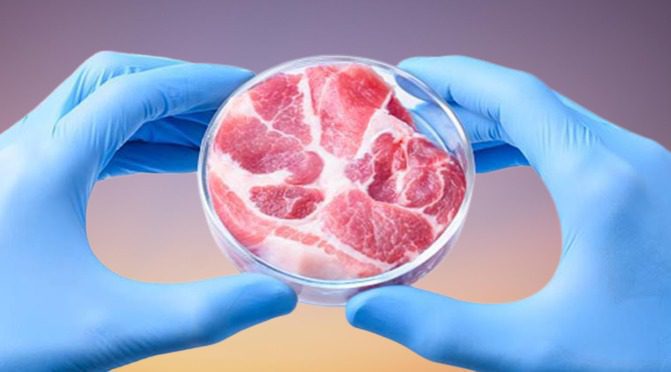Lab-Grown Meat Without Killing Animals: For thousands of years, humans have relied on the slaughter of animals for their meat consumption. However, a visionary scientist named Dr. Uma Valeti had a different dream – a world where people could enjoy meat without the need to kill animals. His solution? Lab-grown meat, also known as cultivated meat, which is created directly from animal cells.
The Birth of Cultivated Meat
Unlike plant-based meat alternatives like Beyond Meat or Impossible, cultivated meat is not derived from vegetable proteins. It is real meat, made from animal cells. Dr. Valeti’s company, Upside Foods, recently received USDA clearance to sell their lab-grown meat. They have set up a production center in Emeryville, California, where chicken is grown in tanks. With the capacity to produce 50,000 to 75,000 pounds of meat annually, Upside Foods is poised to revolutionize the meat industry.
The Process of Cultivated Meat Production
The process begins by extracting animal cells from an egg or live chicken. These cells are then frozen in small vials. Only the highest-quality cells make it to the seed lab, where they become the foundation for growing thousands of pounds of meat. The cells are placed in a cultivator, where they receive a carefully curated mix of amino acids, fats, and vitamins – the essential nutrients needed for growth. This cultivation process aims to replicate the natural environment within an animal’s body, allowing the cells to multiply and transform into edible meat. In just around 10 days, the lab-grown meat is ready to be cooked and enjoyed.
Dr. Uma Valeti: A Dreamer and Innovator
Dr. Valeti’s journey to cultivated meat began with his childhood dream of becoming a cardiologist, a dream that he realized with the support of his parents. As he worked with heart attack patients, he also explored the potential of using stem cells to regenerate heart muscle. It was during this time that he became acutely aware of the environmental impact of animal agriculture. With livestock responsible for a significant portion of human-caused methane emissions and the vast amount of resources required to raise animals for food, Dr. Valeti saw an opportunity to create a more sustainable alternative.
The Growing Interest in Cultivated Meat
Cultivated meat has attracted the attention of venture capitalists and major meat companies worldwide. With nearly $3 billion invested in over 100 cultivated meat start-ups, including Aleph Farms, Believer, Good Meat, Balletic Foods, Blue Nalu, and Meatable, the industry is rapidly gaining momentum. Even industry giants like Tyson and Cargill have recognized the potential and invested in cultivated meat companies. The transition to cultivated meat has the potential to reduce the environmental impact of meat production significantly.
Debates and Challenges
While cultivated meat shows promise, it is not without its critics. Some argue that the environmental benefits of cultivated meat depend on the energy sources used in the production facilities. Reports suggest that energy-intensive processes involving highly refined or purified growth media may have negative environmental consequences. To realize the full potential of cultivated meat, it needs to become more energy-efficient and competitively priced, allowing it to be a viable alternative to traditional meat.
Also Read: Technology Secures Super Bowl LVII
The Future of Cultivated Meat
Though not yet available in grocery stores, cultivated meat has made its way into high-end restaurants. Upside Foods recently served its lab-grown chicken at Bar Crenn, a Michelin-starred restaurant in San Francisco. The taste and texture of cultivated meat have impressed many who have had the opportunity to try it. However, to make cultivated meat more accessible to the masses, it must achieve economies of scale and become more affordable.
Personal Motivation and Reflection
Dr. Valeti’s journey has been marked by personal sacrifice and determination. Despite facing challenges, such as the loss of his father to COVID-19 and stepping away from a promising medical career, he remains committed to his vision. Driven by a desire to create positive change in the world, he believes that unreasonable ideas are often the ones that lead to transformative solutions.
Conclusion of Lab-Grown Meat Without Killing Animals
Cultivated meat represents a groundbreaking advancement in the way we produce and consume meat. With its ability to provide real meat without the need for animal slaughter, cultivated meat offers a cruelty-free and sustainable alternative. While there are still challenges to overcome, the growing interest from investors and the culinary world indicates a promising future. As Dr. Uma Valeti and others continue to push the boundaries of scientific innovation, the day when lab-grown meat becomes a common sight on grocery store shelves may be closer than we think.
Our Reader’s Queries
Do animals have to be killed for lab-grown meat?
Individuals who abstain from consuming meat due to concerns about animal well-being or its impact on the environment might consider experimenting with cultivated meat. Various methods of gathering cells for cultivated meat exist without harming the animal, such as via a biopsy, fertilized egg, or even a feather.
Does PETA support lab-grown meat?
PETA has always been committed to keeping animals off our plates. That’s why we back the idea of creating meat through new technology instead of relying on cruel factory farms and slaughterhouses.
Is lab-grown meat declared safe to eat?
The FDA’s “no further questions” status for Upside’s lab-grown chicken signifies that the FDA has deemed it safe for human consumption. This ruling confirms that the lab-grown chicken is essentially identical to traditional chicken at the cellular level.
How bad is lab-grown meat?
Lab-grown meat has been given the green light by both the USDA and the Food and Drug Administration for safety. The rigorous regulatory standards set by these agencies for food safety are some of the strictest in the world, according to Swartz. This means lab-grown meat is considered safe to eat.

